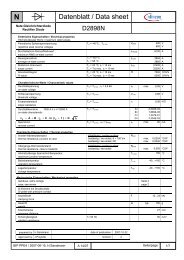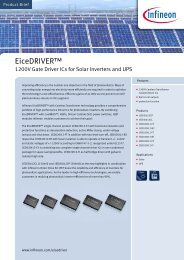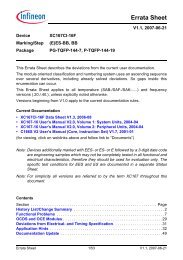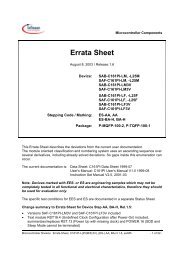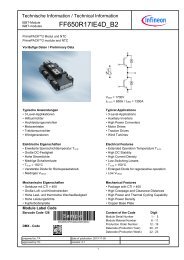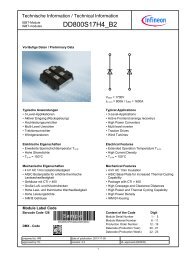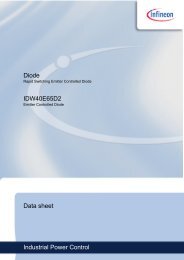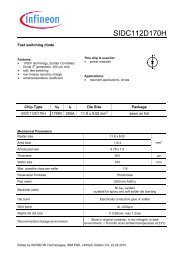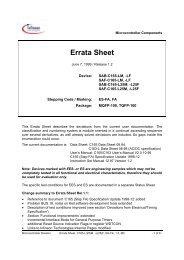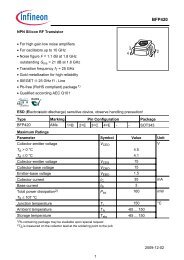Application Note CoolMOS™ CP - Infineon
Application Note CoolMOS™ CP - Infineon
Application Note CoolMOS™ CP - Infineon
You also want an ePaper? Increase the reach of your titles
YUMPU automatically turns print PDFs into web optimized ePapers that Google loves.
CoolMOS TM <strong>CP</strong><br />
- How to make most beneficial use of the latest<br />
generation of super junction technology devices<br />
CoolMOS TM <strong>CP</strong> series has the world’s lowest area-specific RDSon for 500V and 600V MOSFETs, which results<br />
in lowest RDSon per package type. Figure 4<br />
shows technology advances in RDSon and<br />
1995 2006<br />
current rating for 600V class MOSFETs in TO-<br />
220 package, from a 450 mOhm conventional<br />
MOSFET to superjunction MOSFETs. A TO-220<br />
package in <strong>CP</strong> technology can handle an<br />
outstanding high continuous drain current of<br />
more than 30 A.<br />
0.50<br />
0.45<br />
0.40<br />
0.35<br />
RDSon,max<br />
50<br />
45<br />
40<br />
35<br />
As the chip size for a given RDSon rating is<br />
smaller in <strong>CP</strong> technology compared to C3, the<br />
thermal impedance is higher and thus the<br />
current rating is slightly lower when comparing<br />
same RDSon. However, MOSFET selection<br />
should be made based on system thermal<br />
requirements, which means RDSon selection,<br />
and not on current rating. The slightly lower<br />
rating for <strong>CP</strong> compared to C3 has no affect in<br />
the majority of applications as nominal peak and<br />
rms currents are far below the rated currents in<br />
the datasheet. For peak current capability, there<br />
is no compromise between <strong>CP</strong> and C3 series.<br />
The improvements in dynamic characteristics<br />
are substantial in CoolMOS TM <strong>CP</strong>. As shown in<br />
Figure 5, the gate to drain charge, Qgd, is<br />
greatly reduced and contributes to lower turn-on<br />
time and turn-off time. Furthermore, the output<br />
capacitance is as well reduced resulting in lower<br />
energy stored in the output capacitance, Eoss,<br />
for VDS=400V which is a key value for PFC and<br />
ZVS full-bridge topologies. As a consequence<br />
turn-on and turn-off switching power losses drop<br />
considerably for <strong>CP</strong> compared with C3 as seen<br />
in Figure 6. Eon is reduced by a factor of two,<br />
while Eoff is reduced by a factor of 3.3.<br />
RDSon,max [Ohm]<br />
0.30<br />
0.25<br />
0.20<br />
0.15<br />
0.10<br />
0.05<br />
0.00<br />
ID at 25 °C<br />
Standard<br />
MOSFET<br />
450mOhm<br />
Current capability per package<br />
increases with lower RDSon<br />
Standard<br />
MOSFET<br />
420mOhm<br />
Other SJ<br />
CoolMOS C3<br />
MOSFET<br />
190mOhm<br />
290mOhm<br />
30<br />
25<br />
20<br />
15<br />
10<br />
5<br />
0<br />
Other SJ<br />
CoolMOS <strong>CP</strong><br />
MOSFET<br />
99mOhm<br />
170mOhm<br />
Figure 4 RDSon,max and nominal current rating for<br />
TO220 packages, showing technology advances over<br />
time for 600 V rated MOSFETs.<br />
Gate voltage Vgs [V]<br />
12<br />
10<br />
8<br />
6<br />
4<br />
2<br />
0<br />
Lowest total gate charge,<br />
best FoM Ron*Qg<br />
Lowest Qgd,<br />
best ratio Qgd / Qgs<br />
190 mΩ C3 series<br />
199 mΩ <strong>CP</strong> series<br />
0 20 40 60 80 100<br />
Gate charge [nC]<br />
Figure 5 Gate charge characteristics comparison C3,<br />
<strong>CP</strong>.<br />
ID t 25 °C [A]<br />
7 of 32



